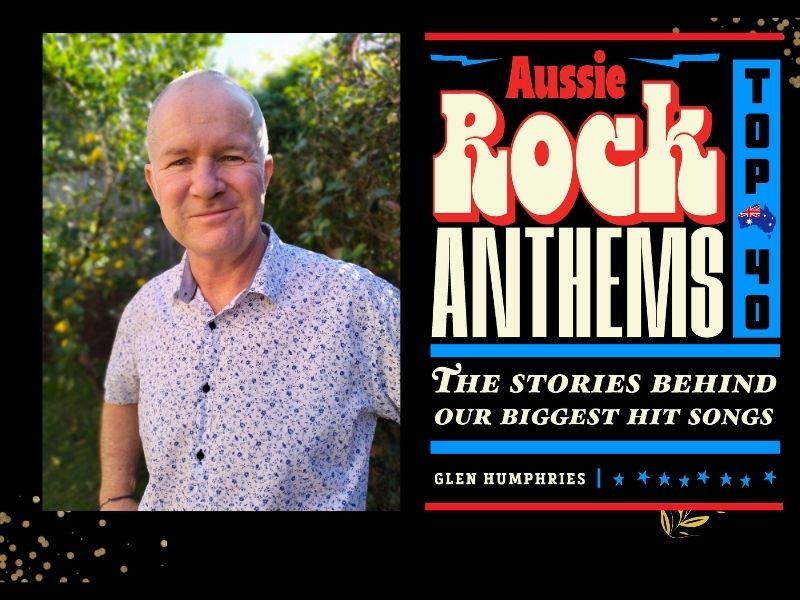Glen Humphries, Illawarra Mercury journalist and author of Sounds Like an Ending: Midnight Oil, 10 – 1 and Red Sails in the Sunset has, presumably with many mates over many beers, compiled the top 40 most “Aussie” rock anthems into one volume, adding the stories behind each song. Lists like these are inevitably subjective, and books like them vary enormously in terms of journalistic quality. Humphries’ book is no exception.
Overall, his list is good – most of these songs do indeed reflect the national musical psyche, being (mostly) songs that great swathes of Australians know, even if they don’t know the song’s name.
Almost all singers here are white males, with only four female vocalists and only two Australian Aboriginal bands. Humphries gives the reason that the music industry has been a predominantly white male affair until around 40 years ago, when artists like Madonna and, of course, Kylie smashed these paradigms.
Curiously, most of Humphries’ choices weren’t actually number one hits. For instance Midnight Oil’s ‘Beds Are Burning’ only got to number 6, AC/DC’s ‘It’s a Long Way to the Top (If You Wanna Rock ’n’ Roll)’ number 9, The Angels’ ’Am I Ever Gonna See Your Face Again’ 58 and Paul Kelly’s ‘How To Make Gravy’ far back at 144. Even Cold Chisel’s stunning debut single ‘Khe Sanh’ only reached 40, showing how culturally ingrained a song can become without actually being a hit (Cold Chisel recently sold out 20 concerts within hours of being on sale, showing the band’s place in the national psyche).
Only some songs were number ones, like Daddy Cool’s ‘Eagle Rock’ (which directly inspired Elton John’s ‘Crocodile Rock’), Skyhooks’ ‘Horror Movie’, Missy Higgins’ ‘Scar’, Silverchair’s ‘Tomorrow’ and Kylie’s ‘Can’t Get You Out of My Head’.
Some aspects let the book down. First, the inconsistent number of pages dedicated to songs, for instance Goanna’s ‘Solid Rock’ gets two pages, Men At Work’s ‘Down Under’ gets seven, yet Divinyls’ ‘I Touch Myself’ gets 10. These inconsistencies run throughout the book. Spiderbait’s ‘Buy Me A Pony’ gets only four pages, and most of these are taken up by photos.
Second, there’s often too much context – too much about the bands, their past albums and almost anything but the songs themselves. For instance, Midnight Oil’s entire first page could have been paraphrased into one paragraph; more than half of Crowded House’s ‘Don’t Dream it’s Over’ chapter tells of their unorthodox methods to get US airplay (that’s a story about the song, not behind the song) and John Farnham’s seven-page ‘You’re The Voice’ chapter has the entire first page discussing another song. In musical terms, this is all filler and no killer.
With books like Adrian Harte’s Small Victories: The True Story of Faith No More and Guesdon and Margotin’s Pink Floyd All The Songs: The Story Behind Every Track, the band’s context is already there, but in a compendium of 40 artists, the writer needs to decide which information is directly related to the song in question, and delete what isn’t, and that’s the problem – a great amount of information in these chapters is information that isn’t.
Because of this amount of nebulously relevant material, to read about the genesis of these songs, just go down some hyperlink rabbit holes on Wikipedia instead. For instance, The Presets’ ‘My People’ chapter goes into just as much depth regarding the song’s origin, meaning and chart success as does its Wikipedia entry.
There are some cool insights – Icehouse’s ‘Great Southern Land’ was written with William S Burroughs in mind, Jimmy Barnes’ anthem for the Aussie blue-collar worker was written by an American, and I bet GANGgajang’s ‘Sounds of Then (This is Australia)’ isn’t about what you think it is.
Personally, I would replace Joe Dolce Music Theatre’s ‘Shaddap You Face’ (I would argue history has forgotten it), with something by TISM. Proof of TISM’s cultural validity is that one of their costumes is in the Australian Music Vault. I’d delete Gotye’s ‘Somebody That I Used to Know’ (an unbelievably annoying whinge that I would be overjoyed to never hear again), and insert some Nick Cave.
These aspects aside, Humphries has created a celebration of both the songs that have been on high rotation on AM and FM radio playlists throughout Australia for half a century, and also the decades when rock ruled the airwaves – when Triple J and events like the annual Big Day Out music festivals epitomised the day’s popular music, most of which was rock.
Music tastes have changed, not least because of technology – streaming services have rendered the music album all but obsolete, with the “album era” now officially in past tense. From this viewpoint, Humphries’ book is a time capsule, one that will get increasingly entertaining as generations go by, when the social contexts of these songs have dissipated into history.
Read: Book review: The Honeyeaters, Jessie Tu
Until then, it will serve well as a coffee table book for Generation X fathers – an intergenerational conversation starter to introduce their kids to songs that shaped the musical, social and political landscape of a country, songs that manifested Australia’s character, culture and conscience.
Aussie Rock Anthems: The Stories Behind Our Biggest Hit Songs, Glen Humphries
Publisher: Gelding Street Press
ISBN: 9781922662057
Format: Paperback
Pages: 240pp
Price: $39.99
Publication date: July 2024





